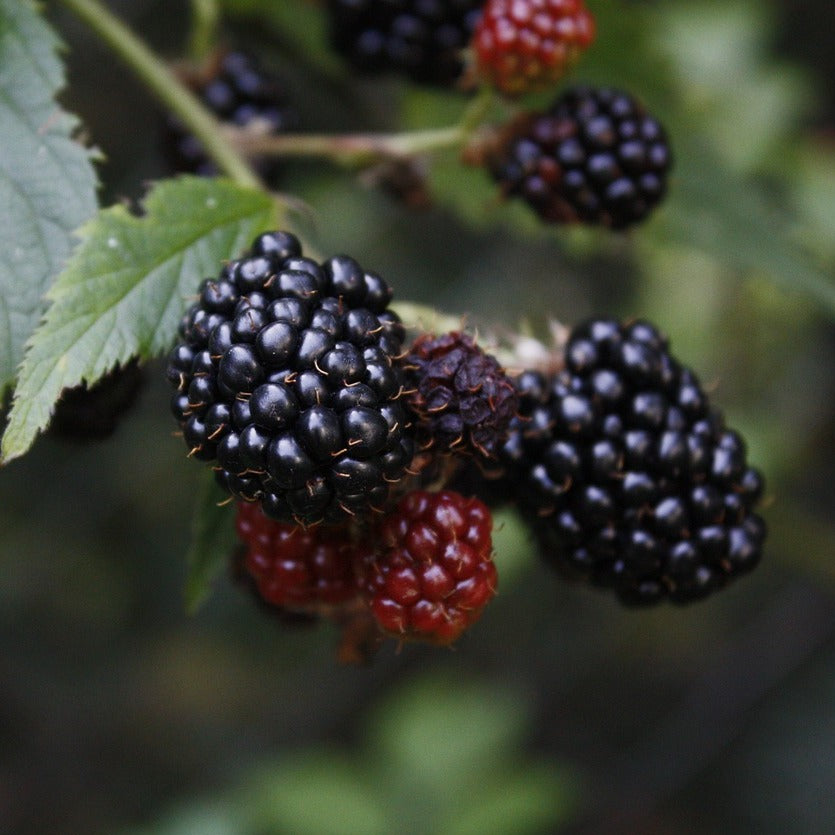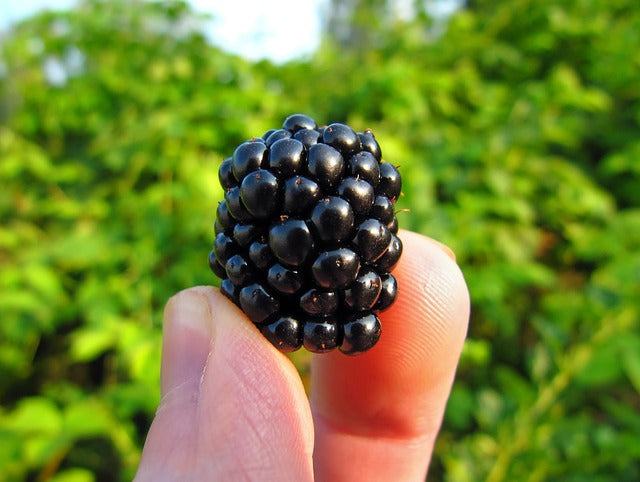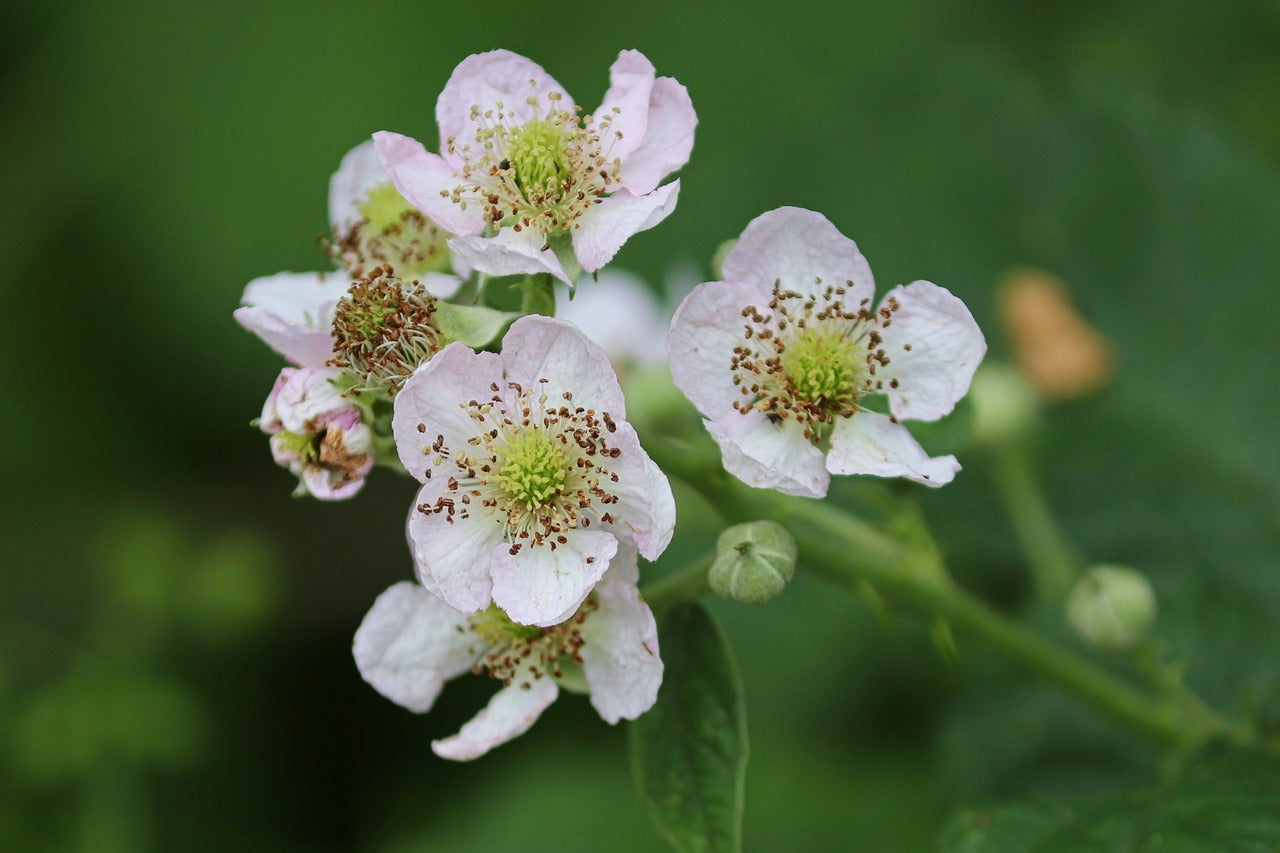The American Fig Company
Triple Crown Blackberry
Triple Crown Blackberry
Couldn't load pickup availability
The Triple Crown Blackberry, Rubus fruticosus 'Triple Crown', is an outstanding addition to any garden, boasting an impressive array of features that make it both a practical and delightful choice for gardeners and fruit lovers alike. This semi-erect thornless blackberry cultivar is renowned for its large, juicy, and incredibly sweet berries, making it a favorite among home gardeners and commercial growers.
The plant exhibits a robust growth habit, capable of reaching up to 5 feet in height and spreading to about 4 feet in width. Its thornless canes make maintenance and harvesting a breeze, allowing for a pain-free gardening experience. The foliage of the Triple Crown Blackberry is a vibrant green, providing a lush backdrop for its white flowers in spring, which transform into large, glossy blackberries by mid to late summer.
One of the most compelling attributes of the Triple Crown Blackberry is its extended fruiting season. Unlike many other blackberry varieties that have a relatively short harvest period, the Triple Crown offers a generous yield from late summer into early fall, ensuring a steady supply of fresh berries over several weeks.
These blackberries are not only exquisite in taste, with a perfect balance of sweetness and a hint of tartness, but they are also versatile in their use. They are ideal for fresh eating, baking, jam-making, or freezing for later use. Additionally, the berries are rich in vitamins, antioxidants, and fiber, making them a nutritious addition to any diet.
In terms of care, the Triple Crown Blackberry prefers full sun to partial shade and thrives in well-drained, fertile soil. It is relatively low maintenance, requiring basic watering, occasional feeding, and annual pruning to encourage productive growth. This variety is hardy in USDA zones 5 through 9, demonstrating good resistance to diseases and pests, which contributes to its appeal and ease of cultivation.
Overall, the Triple Crown Blackberry plant is a superb choice for anyone looking to enhance their garden with a fruit-bearing plant that is not only easy to grow and care for but also provides a bountiful harvest of delicious berries. Its combination of aesthetic appeal, nutritional value, and versatility in culinary use makes it a must-have for garden enthusiasts and culinary aficionados alike.
Latin Name: Rubus fruticosus 'Triple Crown'
Site and Soil: Triple Crown Blackberries prefer full sun to partial shade. They thrive in well-drained, fertile soil with a pH level between 5.5 and 7.0. The plant is adaptable to a range of soil types, from loamy to sandy and clay soils, as long as they are well-drained.
Pollination Requirements: This variety is self-fertile, meaning it does not require another plant nearby to produce fruit. However, having more than one plant can increase the yield.
Hardiness: Triple Crown Blackberries are hardy in USDA zones 5 through 9. They are robust plants that can withstand winter cold and return vigorously in spring.
Bearing Age: Plants typically begin bearing fruit 1-2 years after planting, with full production reached by the third or fourth year.
Size at Maturity: Triple Crown Blackberry plants can grow up to 5 feet in height and spread up to 4 feet wide. Their semi-erect habit may require support in some cases, especially when laden with fruit.
Bloom Time: The plants bloom in late spring, with the flowers giving way to fruit by mid to late summer.
Ripening Time: The fruiting season of the Triple Crown Blackberry extends from late summer into early fall, offering a longer harvesting period compared to many other blackberry varieties.
Yield: A single Triple Crown Blackberry plant can produce 10-20 pounds of fruit once fully mature, depending on care and growing conditions.
Pests & Diseases: While generally resilient, they can be susceptible to common blackberry pests and diseases. Proper care, including good air circulation and avoiding overhead watering, can mitigate many issues.
USDA Zone: 5-9. This range indicates the plant's adaptability to various climates, from cold winters to hot summers.
Share



Featured Review
"Great! Great! Great! Great! Great!"
✰✰✰✰✰
- JARREN -


